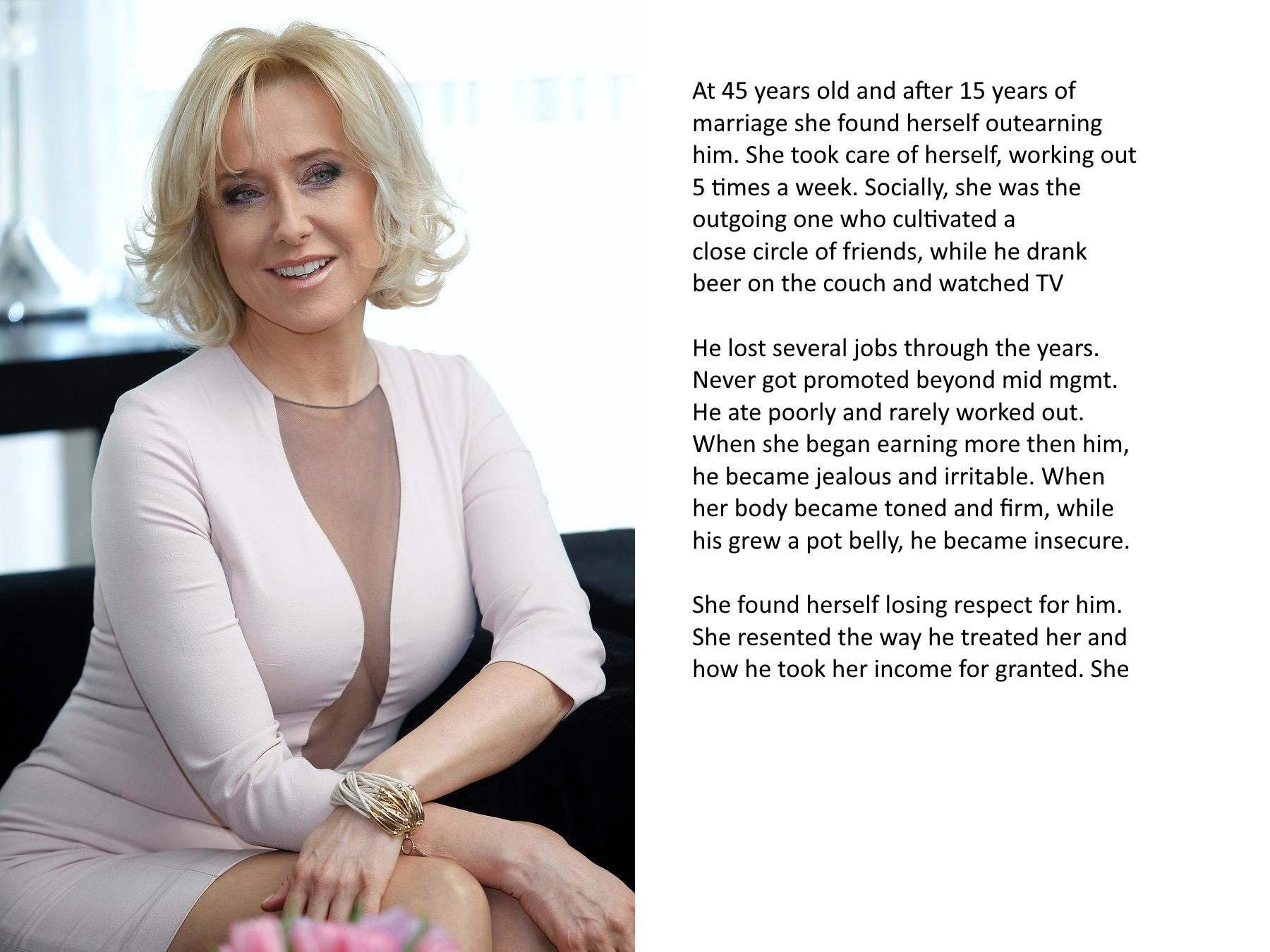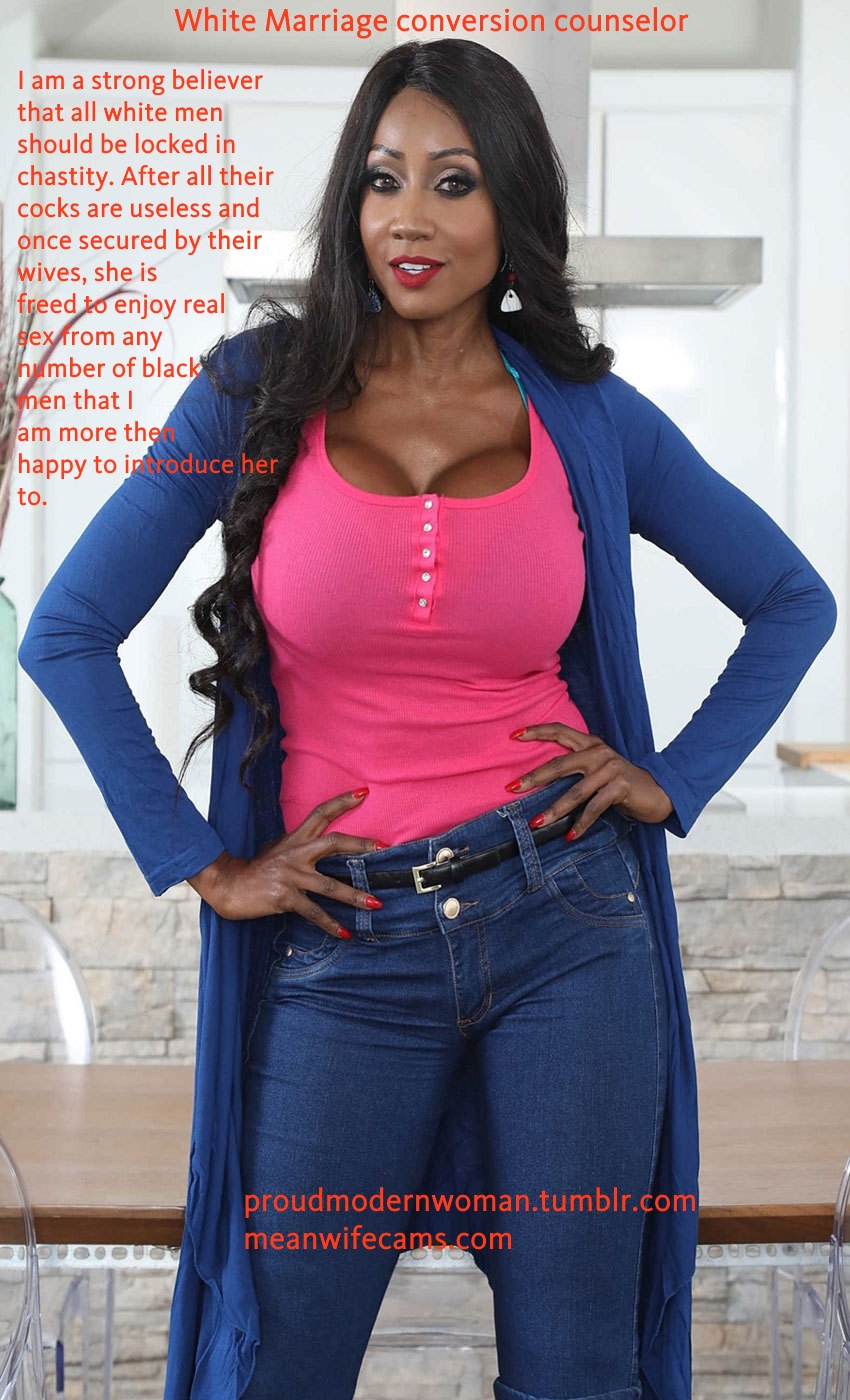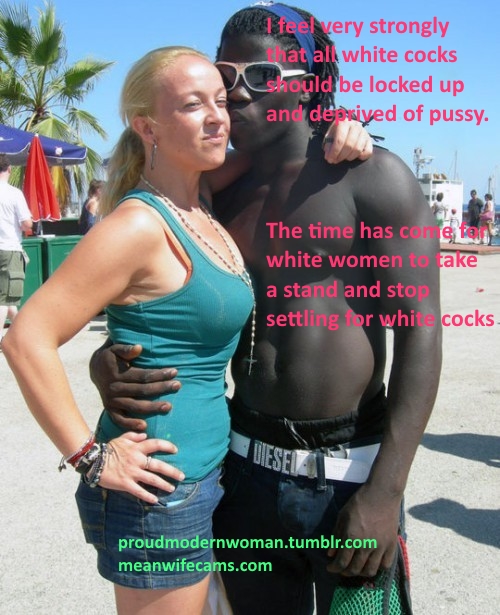
The 100% guaranteed guide to the cuckold lifestlye: LINK
Modern Female Superiority

After all of this it’s vital to continue reinforcing that white women should only fuck black men, and that they should do so with the singular goal of bearing as many black babies as possible. Cuckoldry is mainstream now, and women are openly bragging about being black only, they are proud to display their QOS tattoo’s and are overtly sexual without any guilt or remorse.
White women are openly advertising their sexual availability to black men, and making it clear that interracial relationships, open cuckoldry, and cheating with black men is perfectly normal. These women are thrilled if they are being pumped so full of African seed that their first pregnancy with a black baby is guaranteed. Just consider how popular it has become for the black men to explode deep in their costars receptive womb.
White men have been totally emasculated, they have been feminized, and totally neutered socially and sexually so completely that if you have not introduced chastity into your relationship then you should, because white boys have been conditioned to desire it in the same way white women have been taught to pursue interracial breeding.

These weakened white male genes will be eliminated completely because white women will always side with their nations conqueror and have never had any biological tribal loyalty like all the other races do so within a few generations white women will have ensured their own genocide.

Real Women for Long Term Female Led Relationships
Once I started taking male chastity serious the results were enough to convince me that this could no longer be a game of fantasy that we played on a part time basis. I quickly realized that this was the reality that I wanted and I could no longer settle for what had become a mostly traditional marriage. It was a Friday night when I told Gary that chastity would be becoming a full time part of our marriage. I could tell he was stunned and a bit fearful. His hesitation, while annoying, was expected. He countered that maybe we could gradually increase our chastity play and over time see how it was working for us, and then come to some mutually agreeable compromise. I laughed in his face at his naivety before adopting a serious tone again. I replied that this wasn’t a negotiation and that I in fact had already made the decision. His only options were to cooperate or face divorce. What was it going to be? His silence spoke volumes and before he could answer I firmly demanded that he stand up and remove his shorts. My tone was serious and confident. Without speaking he complied. two minutes later the click of the lock formally changed our marriage forever.
Check out the complete guide to Male Chasity in a FLR
This was over a year ago, and while there have been some bumps in the road, the decision to take permanent control over his most prized possession was the best decision I’ve ever made. I now wear one key on my ankle and keep the spare at my office. His releases are brief and at my sole discretion. In essence he has become the housewife giving me the free time to socialize with the girls at happy hours and spend more time at the gym without having to worry about getting home in time to clean house, do my laundry, or prepare dinner. His ability and willingness to provide me oral pleasure improved 500%. While some call this “enforced chastity”, it is important to remember that he was given the option of exiting the marriage. Something I was fully prepared to do. I am thankful that he chose to accept his new role along with the realization that he is no longer my equal. He occasionally asks me if I think we will ever go back to a “normal” marriage in which I reply this is normal. This is the new Modern Marriage.
It’s a fallacy that the wife needs to wait until her husband in not aroused before she can lock his cock safely away. In a Wife Led Marriage, she decides when the lock goes on, regardless if his little dick is ready for it.
Six years ago, when Daniela Syrovy became pregnant with her first child, she planned to take a maternity leave. She would step away from Clutch, her fledgling public relations business, while her husband, Tim Kelloway, would continue running Big Burger, his Etobicoke restaurant. Then their daughter Suri was born. Daniela, now 33, recalls the moment with perfect clarity. “I’d just gone through labour and our whole family was in the room. It was really emotional, and the midwife handed me the baby. I felt completely bewildered by this little stranger, and then I saw Tim was crying. He looked in my eyes and said, ‘Now I understand why I was put here.’ And I told him, ‘Well, thank Christ one of us feels that way!’”

Six months into motherhood, Daniela was overwhelmed. While the baby was thriving, the dishes and laundry were piling up, and she was ordering in dinner every night. Tim proposed, in the gentlest way possible, that he take over the primary parenting.
Now the couple has three children—Suri, who is five, four-year-old Viiva and two-year-old Lennon Peach. Tim has sold the restaurant and is a stay-at-home dad.
“He does everything around the house, and I make all the money,” Daniela says. “It’s that simple.”
The Syrovy-Kelloways are one of a growing number of Toronto families in which the mother is the sole breadwinner and the father takes care of the kids. They are pioneers in the new frontier of family life. In 2011, according to a Statcan study, 12 per cent of two-parent Canadian families had a stay-at-home dad, up from seven per cent in 1996 and one per cent in 1976. That’s higher than in both the U.S., where the rate is only 9.5 per cent, and the U.K., where such families account for 10 per cent.
The trend toward domestic role reversal has come as a direct result of the rise of mothers in the workforce, which crucially crossed the 50 per cent mark in the ’80s, when today’s generation of young urban professional parents in their 30s were growing up. Last year, a Harris-Decima poll found that Canadian women are the primary breadwinners in a staggering 26 per cent of married or common-law relationships.
Breadwinning moms and their caregiving male partners are not just growing in number: they are overhauling the way we think about gender, success and domestic life. “Today’s generation of young parents were the first to grow up watching most of their mothers work and many of their fathers actively participate in domestic labour,” says Nora Spinks, the CEO of the Vanier Institute, which tracks social trends among families. Whether these couples are making a conscious choice to buck the norm, struggling with the practicalities of raising a family in an expensive city or simply doing what feels right to them, they are testing the liberal truism that an enlightened woman can bring home the nitrate-free bacon and her man can fry it up. Toronto is becoming a city on the vanguard of the reordering of domestic labour.
On a visit one mid-week morning to the Syrovy-Kelloways’ Junction house, I’m treated to a typical snapshot of swirling domestic chaos: Suri and Viiva dash naked through the house yodelling like mad Swiss nymphs, while their baby brother, Lennon Peach (clad only in a Batman tank top), saunters into the kitchen holding a half-eaten cob of corn and demands “Mo’!” Daniela sips her coffee and checks her phone as Tim takes the unfinished cob from his son, mimes throwing it in the garbage and then—in a deft parental sleight of hand—pulls it out of the fridge as if brand new. Satisfied, the toddler staggers from the room chewing his “new” snack. Tantrum averted, Tim settles back down at the table. But only until the next holler or demand.
The Syrovy-Kelloways have always shared what they’ve earned—everything goes into and comes out of the same pot. Even back when they were still dating, and struggling to get the restaurant off the ground, the couple had a joint account. Daniela’s friends thought she was nuts, but the idea of not sharing with Tim seemed strange. “Right from the beginning, even before the kids, we were completely intertwined,” she says.
Today Daniela makes between $80,000 and $100,000 a year from her PR business. They calculated that even if Tim went back to work and pulled in about the same, with three small kids in daycare at roughly $1,500 a month each, after taxes they’d be back in the same place they started—only with someone else raising their children. When other middle-class, dual-income families arrive at the same impasse, it’s the wife who usually puts her career on hold to raise the kids.
The division of labour between Tim and Daniela is as stark as it is between Don and Betty Draper—but in the new scenario, the childminder wears surf shorts and the breadwinner a vintage lace blouse. Tim even sounds like a typical underappreciated housewife, complaining good-naturedly about Daniela not cleaning up after herself (“I quickly learned it was easier just to do it myself,” he grumbles).
They get by the way most families in the squeezed, educated urban middle class do: by scrimping on the things that don’t matter to them and spending on the things that do. For a few years they didn’t have a car (an experiment that ended last summer—they are now the proud owners of a used minivan). They don’t take the kids to Canada’s Wonderland or spend their money on tacky plastic toys. There is, however, quiche on the table for breakfast the day I visit and organic veggies in the crisper. They take a family holiday every winter and Daniela recently insisted Tim go on a trip to Mexico on his own because he needed a break. Last winter, Daniela spent a month at film festivals in Germany and India—a trip she describes as both business and pleasure. When other mothers said to her, “You left your husband alone with your children for a month?” she’d retort, “You married a man you wouldn’t leave your children alone with?”
Many women who seek a Female Led Relationship have turned to online dating sites that cater to Alpha Women and Beta Man. The most popular of these sites being Alt.com
Many Wives in a Female Led Marriage lock their husbands cock in chastity and wear the key that symbolizes her position in the marriage.Daniela makes perfect sense to me. Like her, I am a new mother who has little interest in raising children full time and a lot of interest in my work. I’d say this is true of roughly 80 per cent of my female friends with young kids. We work because we want to, and because it’s more interesting and better paid than the alternative.
It’s Tim who fascinates me. What I want to know from him is this: How, as an educated, privileged man with every advantage in the world, has he chosen to do the work that women—for millennia society’s chattel and drudges—fought so desperately to get out of? How does he cope with the fact that his wife’s work is rewarded with money and status and gala invitations while his is essentially invisible—except to a narrow selection of small self-absorbed humans with insatiable corn demands?
He listens to the question, and then shrugs. “I guess I just don’t need that kind of validation,” he says. But when I press a bit further, something in him hardens. “Look,” he says, “you have a kid, right? So who’s with your kid right now?
A nanny, I tell him.
He nods. “Well I can tell you something. Your kid doesn’t want a nanny. Your kid wants you. Your kid needs you.”
I start to say that I have to work, and my partner has to work, and he waves his hands like he’s heard it all before—and of course he has. The truth is, I don’t have to work. I want to work. My son would be delighted if I sat in the backyard playing “eeny-meeny” with him all morning as Tim does with his kids. “I just don’t think saying ‘I work’ is much of an excuse for not raising your children,” Tim explains. “For me, it’s just not good enough.”
And of course, like centuries of unseen, unthanked stay-at-home moms and hardworking housewives before him, he has a solid point. It’s just astonishing to hear a man make it.
Once I started looking for stay-at-home dads, I found them everywhere. Visit any Toronto playground during the week and you will see fathers congregating among the usual crowd of moms, grannies and paid caregivers. These men are, for the most part, stylishly casual, well-educated former professionals who have given up offices and after-work drinks for BabyBjörns and Rainbow Songs. Some are on leave (29 per cent of Canadian men now take paid parental leave, up from three per cent in 2000) but many have quit their jobs, content to be dependent on their wives—at least until the kids are ready for school.
This generation of stay-at-home dads grew up in the ’80s and watched Three Men and a Baby and Mr. Mom—movies that placed their finger firmly on the cultural bruise that working women had left behind when they walked out of the house in a power suit and high heels. Through breast pump gags and exploding diaper jokes, these films asked one of the great sociological questions of our age. “Okay women’s lib, what’s next?”
Some of these dads complained to me of feeling trapped by their new roles. To remedy their isolation, they’ve developed a “dad culture”—in which fathers meet and mingle in a manner previously reserved for their female counterparts. There are now dozens of daddy bloggers who proudly share jokes about baby puke, parenting tips and photos of their kids at the park, at the cottage, in the tub and watching sports with dad.
David Eddie, a Toronto-based columnist and author, stayed home to look after his three boys when they were small, while his wife, Pam Seatle, an anchor on City News, worked to support their young family. The experience formed the basis for his book Housebroken: Confessions of a Stay-at-Home Dad. Looking back on those years, Eddie feels that his kids got the best of both worlds: a dad at home and a professional mother who would come home after a hard day at work and—instead of opening the paper and drinking a martini by the fire—dive right in. “Sometimes she’d come through that door just as I was about to friggin’ lose it,” Eddie says. “And thank god, she’d kick off her high heels, change out of her suit and into sweats, and get involved.”
I met one bearded, affable 35-year-old stay-at-home dad, Stuart Henderson, who is a historian and the author of Making the Scene, a book about Yorkville in the ’60s. After completing a contract teaching Canadian history at McMaster University, Henderson took some time off to care for his sons, two-year-old Noah and four-year-old Angus, while his corporate lawyer wife, Sarah Lowy, supports the family. Henderson does some freelance writing on pop culture and Canadian history on the side, but most of the childcare now falls to him. He describes his family’s financial state as comfortably middle class. He and his wife maintain both joint and separate household accounts. Henderson isn’t ready to give up work in the long run—far from it—but while he and his wife struggle through the weeds of new parenthood, he’s committed to being a house husband. “Among my guy friends, me being a stay-at-home dad has become an easy joke,” he says. “I’ll say I had a tough week, and they’ll say, ‘Why? You don’t even work!’”
Henderson admits he sometimes felt like an interloper in the world of baby activities. When he took his then six-month-old son to infant swim class, he was startled to discover he was the only man there. “It was all women but me,” he said. “They’re all about six months post-birth in bathing suits, probably feeling weird about their bodies—I’m sure the last thing they wanted was a man in the pool.”
The social rules for stay-at-home dads are still being written. Syrovy has noticed that some of her girlfriends are wary of including her husband in their circle of moms. Her stay-at-home mother friends still insist on texting her, rather than Tim, to set up play dates, even though they know he’s the one they’ll be meeting with. “I think they just feel uncomfortable connecting directly with him because they’re worried about how it looks. It doesn’t matter how many times I explain to people, ‘I have no idea what’s going on at home during the week.’ They think I’m the point person.”
Slowly but surely, the stigma against stay-at-home dads is disappearing. “I was honestly expecting a lot more prejudice,” says Brian Sinasac, a 42-year-old former animator with one-year-old twins. When his wife, Elizabeth, a 40-year-old senior policy analyst with the ministry of education, finished her maternity leave earlier this fall, Sinasac (who had also taken a year-long leave) decided to say home for good. “I’ve had a few Mr. Mom jokes,” he admits, “but what gets me is when people ask if I’m babysitting. I want to say, ‘I’m not 13 years old. These are my children. It’s called parenting.’”
Breadwinning moms may be more inclined to work outside the home than their husbands, but that doesn’t mean they have an easy time admitting it—to themselves or anyone else. It took Shannon Barnes, an attractive, blonde Toronto-based television commercial producer in her early 40s, two years to tell people that her husband, the landscape painter Jeremy Down, had become a stay-at-home dad since she gave birth to their now four-year-old daughter, Harper. Barnes, who earns around the low six figures, was self-conscious about being the primary breadwinner. “I found myself making excuses and apologizing for the fact that he was doing 99 per cent of the childcare while I was working,” she says. “But if the gender roles were reversed, no one would bat an eye. It took me a long time to just say, ‘He’s being a dad right now and you know what? He’s awesome at it.’”
Johanna Braden, a civil litigator with three children who lives in the Annex, was astounded by the blowback she and her husband, the employment lawyer Peter Cuff, encountered when he quit practising to be a full-time dad for their small children. “He was more temperamentally suited to staying at home, so that was the decision we made. But some people were reluctant to believe he’d leave a good job willingly. It was like ‘Oh, is he being pushed out? Or does he have a secret drinking problem?’ They couldn’t get their heads around it.”
Many of these moms describe a reluctance to admit that their husbands are simply better equipped as homemakers than they are. Shannon Barnes grappled with feelings of maternal guilt after returning to work. Her job requires a great deal of travel, and during those periods she is on call and fully immersed in the stressful, high-pressure world of commercial production. “At first I missed my daughter terribly, but there was this incredible sense of freedom,” she recalls. “The guilt I felt wasn’t about neglecting her. It was about how much I enjoyed being back, surrounded by grown-ups.”
The stay-at-home dads I’ve met, on the other hand, didn’t say, “It was hard for me to accept that my wife is a corporate lawyer and makes $350,000 a year on Bay Street.” This reveals less about men and more about the extraordinary pressure society places on working mothers both to be thin and high-earning, and to knit blankets in their spare time. Feminist commentators have devoted acres of copy to why this dream of “having it all” is essentially a raw deal for women (see Anne-Marie Slaughter’s “Why Women Still Can’t Have it All” and Sheryl Sandberg’s Lean In for details), but they often leave out one crucial factor in the debate, and that is the role of men.
Here’s the thing: if men choose to forgo their careers and stay in the home and are good at it, then a working mother can absolutely have it all—a high-flying career, secure children, a clean house and dinner on the table every night. The problem is that most educated, high-earning, ambitious, successful women tend to pair up with educated, high-earning, ambitious, successful men. And when children come along, those ambitious women face an impossible choice: outsource their children’s upbringing or dial back their careers. Most still choose the former.
Leah Eichler, the founder of Femme-o-Nomics, a website for professional women, says that most women she talks to “don’t want to give up that dream” of marrying a partner who has their earning power or better. Even for strident feminists, she says, “there is some embarrassment in saying, ‘My husband is not as successful as me.’”
It’s fascinating to me that women—theoretically the more nurturing sex—are far more likely to choose their spouse based on status and earning power than domestic capability. It seems we want men who have the capacity to support us financially, even if what we really need is dinner cooked and someone to do the grocery run. This instinct, which many evolutionary biologists believe is an anxious throwback to our hunter-gather ancestors (man hunt; woman tend home fire), doesn’t serve working mothers particularly well in 2013.
Let me put it another way: how many educated, high-powered working moms do you know who grew up thinking, ‘One day I’ll meet a sweet, kind man who I can financially support while he raises our children and redecorates the house’”?
Daniela expressed trepidation to me about being included in this article—not because her children would be exposed or her husband’s choice to stay home would come under scrutiny, but because she chose to prioritize her career. “The fact is, I’m just not very maternal,” she says. “I’m focused on my career and always have been. There’s a part of me that never switches off. I sometimes, quite literally, don’t know how to be with the kids. Tim never has that problem.”
“I’m the only one who makes the bath water the right temperature or cuts the apple properly,” Tim tells me. “Sometimes Daniela would be right there but the kids would want me. It bugged her for a while—she went through a period of feeling like a failed mother.”
Daniela says she’s become closer to her mom, who adores and respects Daniela’s stay-at-home husband, but more distant from her conservative eastern European father. “He’s just confused by Tim, and always has been,” she says. “When the outside world doesn’t accept our scenario, we just ignore it.”
I admire men like Tim for being social mavericks, but at the same time I’m skeptical that they’ve found the perfect family model. These educated men have chosen to take up the lesser role in an outdated domestic division of labour. I don’t believe the model mankind pursued for all those millennia—one half of the partnership a household drudge, unable to own property, vote, have a career outside the house, while the other half earned money, went for lunch and had a tangible stake in the world—was working. It was a raw deal for women, just as it appears to me a raw deal for the men who are taking it up.
The problem, of course, is children. What to do with these small, delightful and frustrating humans who require 24-hour surveillance? What do they deserve? How can we do right by them while also doing right by ourselves?
Just as I’m winding up my visit with the Syrovy-Kelloways, Tim rises from the table to check the kids, then begins charging up and down the stairs, from one end of the house to the other. Daniela ignores this and continues chatting. Finally, I ask what’s wrong. “I can’t find the girls,” Tim says, striding through the room, flinging open closets and cupboards. “They must be hiding.” He heads into the backyard to check the shed, and Daniela offers me more coffee. I wonder if she isn’t a tiny bit worried, what with her two young daughters theoretically scampering naked across the city’s west end like a pair of runaway wood sprites.
“He’ll find them,” she says. “He always does.” Then she smiles serenely and goes back to sipping her coffee and talking about work.
Women are excelling both professionally and personally. As more women break through barriers historically reserved for men, their attitude towards their mate changes. The marriage dynamic changes as these women recognize the benefits of a Female Led Relationship, or Wife Led Marriage. In the United States the trend of women assuming the dominant role, both at home and professionally is at an all time high. This changing relationship dynamic is often referred to as a “Modern Marriage”
With more women in traditionally male dominated fields, like BigLaw and Wall Street, it’s no surprise that the number of stay-at-home “house husbands” is increasing. However, until recently, female partners didn’t like revealing the fact that their spouse took care of the house, the ABA Journal reports.
This shift in gender roles should be embraced rather than hidden, so here are some thoughts on making it work in your family.
The Rise of House Husbands
Women make up 70 percent of staff attorneys at BigLaw firms. Unsurprisingly, women with families in those positions may struggle with finding a work-life balance. Enter the house husband — dads that stay at home with the kids and keep the household running while mom is at work.
Now that your husband is voluntarily cleaning up, it’s surprising that only recently were Big Law women admitting that their husbands were stay-at-home dads. In the past, women would simply tell people that their husbands were “working on the side” or “doing consulting,” rather than say he’s a house husband, according to the Journal.
While it may be difficult to shake deeply entrenched gender roles overnight, families shouldn’t be embarrassed by the new dynamic. Many women don’t feel like they can have the same work-life balance that men can. So why not embrace the fact that you have a wonderful partner at home who’s holding down the fort?
It’s important for couples to communicate their personal expectations of the working-wife/house-husband dynamic with each other. In the stay-at-home dad role, men often feel alienated, especially if their new colleagues are stay-at-home moms, the Journal said. Consider sending the kids to daycare for a couple hours a day, so that dad has some time to himself away from the playdates.
Also, even if you’re exhausted after a day of dealing with complex legal issues, don’t minimize the work your house husband has done. It’s also exhausting running after kids all day, prepping meals, and cleaning up around the house, so try to pitch in when you get home. After all, your husband is a stay-at-home dad, not your housekeeper.
The bottom line is that finding work-life balance in Big Law jobs is borderline impossible, so appreciate your house husband and his efforts in supporting the family.
Original Article https://blogs.findlaw.com/greedy_associates/2014/01/the-real-house-husbands-of-big-law-make-it-work-for-you.html

More and more black women are taking a role in converting their white sisters to the joy of BBC and cuckolding. They call themselves “cuckold counselors“. Introducing the white couple to male chastity is how they do their part to improve the world.
More and more femdom’s are keeping their cuckold in extended durations of Male Chastity. Orgasm control and denial is the cornerstone of a Female Led Relationship – AKA a “Modern Marriage”
Want a Cuckolding Marriage? They all start with a helpless, locked, limp, white cock!
Need a male chastity device? Visit the Female Led Store and begin your journey towards a Modern Marriage!




